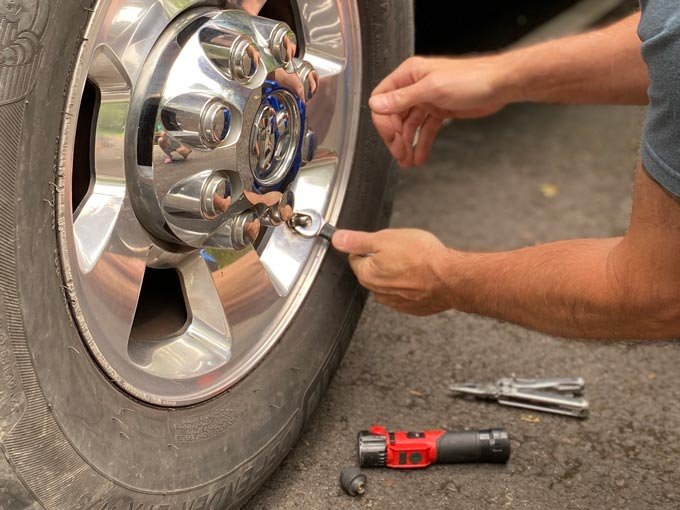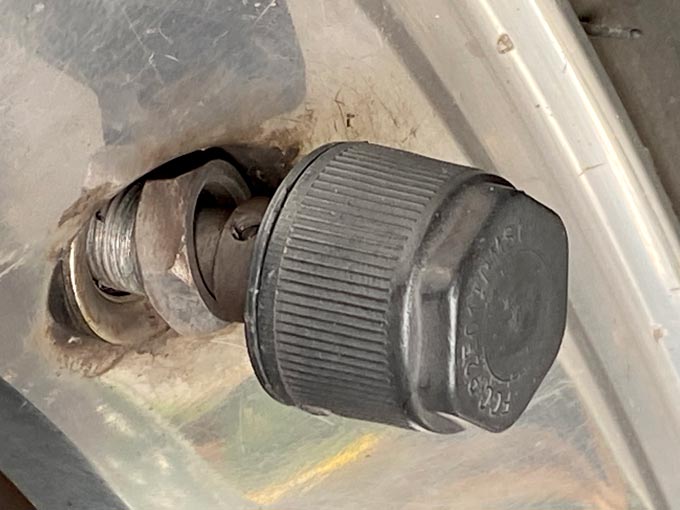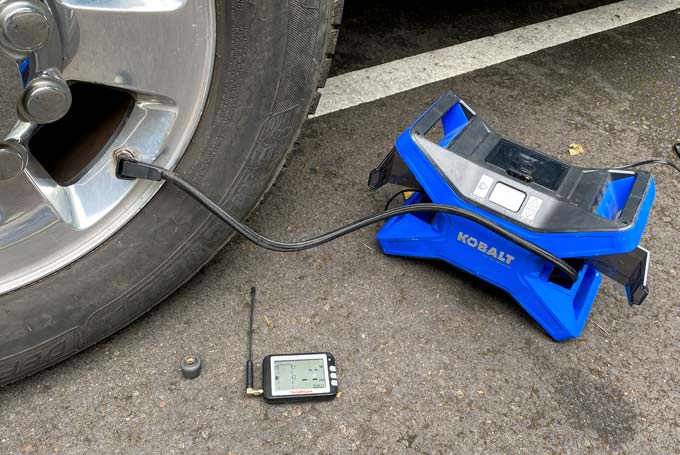If you ever wonder why you need a TPMS, here’s another real world example for you. We’ve written about our Tire Pressure Monitoring System quite a few times before. Recently we had another close call, when it saved the day once again. And this is why you need a TPMS.
A good TPMS is a must-have for any RVer. Thankfully, this time we weren’t hauling at the time ours sounded its dreaded alarm. Rene was driving along the narrow winding two-lane road from Eugene, Oregon to enjoy a peaceful day out at the coast…BEEEEP! I immediately grabbed the TPMS. Rene immediately freaked out. We both checked the mirrors. There was no thump or sudden sound – other than the alarm. We clearly didn’t have blowout. But we could at any minute, and this is why you need a TPMS.
The display on our Tire-SafeGuard TPMS indicated we must have had a slow leak. The pressure of one tire had dropped below the minimum threshold I set. And it was holding steady. I calmly suggested Rene pull over the the next safe chance she had to do so. A quick check of the Maps app suggested that was no time soon. The pressure indicator dropped again. We were losing air. It wasn’t a sudden loss of pressure, so I wasn’t too concerned. But concern was mounting as the pressure dropped once again.

Why You Need a TPMS: Peace of Mind
Our TPMS gave me the peace of mind knowing that we needed to stop soon. And, the monitor told me the issue was not so urgent that we needed to stop in an unsafe location along the narrow road with no shoulder. Rene continued to drive very carefully as I monitored the monitor. In what seemed like much longer time than it took, we came upon a small campground and pulled in.
At first glance it was very clear we had no drastic drop in pressure. I closely inspected the tire for any sign of puncture. But I couldn’t find any obvious signs. There would have been no way of telling we were losing air in the tire. And this is why you need a TPMS.
Then I noticed the valve stem.

The nut on one of the metal valve stems we installed on the truck wheels had come loose. It was slowly leaking air from the valve stem seal. Had we driven much longer like this, we may have experienced a sudden loss of air pressure. Or worse, we might have had a blowout. I hate to think what may have happened with the trailer in tow. This is why you need a TPMS.

It’s times like this you also need a good DC powered air compressor. I tightened the valve stem nut, while Rene looked for a tire shop in Florence, where we were headed for a day out and about. The threads on the valve stem appeared to have stripped. Our plans changed because the situation was the boss once again.
The Les Shwab Tire Center in Florence determined that the valve stems were the wrong size. Though they’d been working fine for a couple years now, the gasket was not seated properly. We had them swap out the stems and check all four tires. They squeezed us in immediately, and a team of techs got to work like a pit crew. They had us out of there in 23± minutes according the big digital clock on the shop wall.

We still had time for lunch and a stroll along the dock with Nellie. We made the trek back to town feeling assured that the tires were all in good shape. Knowing that we’d be notified immediately if not, if that beep sounded again. And this is why you need a TPMS.
What Is the Best TPMS?
Our Tire-SafeGuard TPMS has served us well. It’s saved us from much worse days, a number of times. But it is no longer supported, and hasn’t been for some time now. Getting replacement sensors or service would be impossible. The company seems to have long since shut its doors. I’ll keep replacing batteries as long as we can to keep our TPMS keeping us safe. At some point, I’m sure we’ll be shopping for a new Tire Pressure Monitoring System.
If you have a recommended model, for truck and trailer, please tell us more with a comment below. I like having a handheld wireless monitor, and am not a fan of app based systems. Discuss…
We also had the Tire-Safeguard TPMS but recently were having problems with the monitor not getting updated information from the tires. We would have the system get a temp and pressure first thing in the morning, and four hours later the numbers for the tire had not changed. We have a newer truck with its own TPMS, so ours is for the spares on the truck and trailer plus the four trailer tires. After researching we ended up with the TST 507 with cap sensors. After four days and about 800 miles we are feeling much better about our TPMS. The new system has given a couple of false alarms when losing contact with a wheel sensor, but that was only a problem once when the monitor did not stop beeping. The other time it picked it back up within seconds. The TST system includes a repeater, which is something the Tire-SafeGuard did not have, but apparently had as an option the company could provide. Without any support we could not get one. The TST is basically the same as the Tire-SafeGuard, but so far, seems more reliable. We did have a problem with getting the sensors programmed with the monitor, but a call to TST got a quick response and a solution to the problem. After another 2000 miles to home we will know for sure.
Good to know, thanks! So far, replacing batteries does the trick for our good ol’ Safeguard…though actual support sounds nice